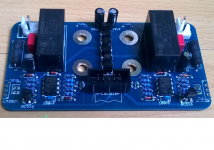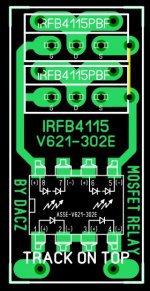You are reading but not assessing the content. Read and understand and discard the chaff.
Waiting for the DC on the power supply to sag enough to allow the relay to drop out could take 10000ms, or if you arrange for a very low charge storage one could get down to maybe 1000ms
Too slow, by more than a decade and could be three decades slower to isolate.
"delay to ON and instant OFF isolates the speaker before tha amplifier starts to shut down."
With this solution the relays are off way faster than the amplifier starts to shut down (especially if you add a regulator and very sensitive relays).
PS : You could perhaps try a 7805... and measure the delay ?
Last edited:
Yes, Bonsai and others have implemented SS relays.Does this look like a viable solution after the smoothing caps ?
A DC Fault Protection Circuit for Audio Amplifiers
Sorry not $5.
I have already implemented slow release and faster release and Bonsai's NX PSU with a very fast release."delay to ON and instant OFF isolates the speaker before tha amplifier starts to shut down."
With this solution the relays are off way faster than the amplifier starts to shut down (especially if you add a regulator and very sensitive relays).
PS : You could perhaps try a 7805... and measure the delay ?
But loss AC detection is far faster than any of those.
I have the PCB kit as being discussed in this Thread. It is potentially slow because it does not have loss of AC detection.
If it were powered from the Main PSU to avoid the cost of a separate low voltage transformer, then it becomes far too slow.
Sajti's post34 sch with a separate transformer and low charge PSU can be made acceptably quick for a power amp isolation. But may still be too slow for a fast reacting source that shuts down very quickly. I know I have tried it and used it.
Andrew, I have build the SS relay circuit and it switches via a UPC 1237 IC. The circuit is driven from AC. Startup takes about 7s for mosfets to switch on and on power down it is immediately. Works very good.
Interesting: could you show the schematics?
Thanks,
Jacques
I have already implemented slow release and faster release and Bonsai's NX PSU with a very fast release.
But loss AC detection is far faster than any of those.
I have the PCB kit as being discussed in this Thread. It is potentially slow because it does not have loss of AC detection.
If it were powered from the Main PSU to avoid the cost of a separate low voltage transformer, then it becomes far too slow.
Sajti's post34 sch with a separate transformer and low charge PSU can be made acceptably quick for a power amp isolation. But may still be too slow for a fast reacting source that shuts down very quickly. I know I have tried it and used it.
I've designed a circuit by myself because it seems extremely difficult to detect defects in the AC.
When the stormy weather is here, there are some erratic small and fast series of power cuts, and all boards that i've buyed (including mainstream market amplifiers) or designed are in trouble.
How can you differtiate small cutted and distorded sinewaves of the regular distorded and dephased sinewaves please ?
Last edited:
What do you think about SC protection?
http://www.diyaudio.com/forums/solid-state/120614-loudspeaker-protection-circuit-2.html#post4844425
I have modified a little PCB (not posted here) to accept larger inductor.
So what id your opinion about relay response time, DC detection time and Power-Off detection circuit?
http://www.diyaudio.com/forums/solid-state/120614-loudspeaker-protection-circuit-2.html#post4844425
I have modified a little PCB (not posted here) to accept larger inductor.
So what id your opinion about relay response time, DC detection time and Power-Off detection circuit?
Jacques, I have used the same schematic which you have posted from Build amps and I have modified the board to take opto isolators and the mosfets.
Hi Jan,
Which opto isolator did you use? "TLP591" or "ASSR-V622-302E" ?
And which mosfets?
Thanks,
Jacques
Hi, I noticed your edit, it's "bought" I hope you don't mind

- Home
- Amplifiers
- Solid State
- Speaker Protection Kit for under $5

